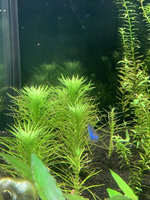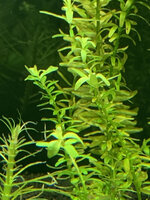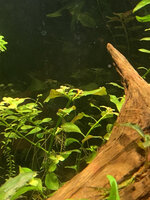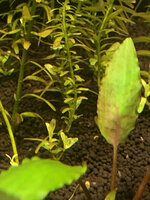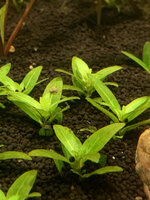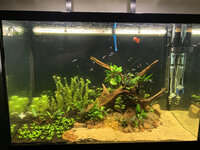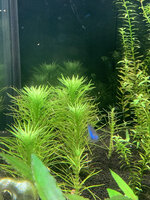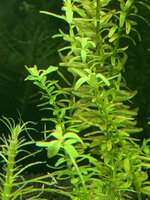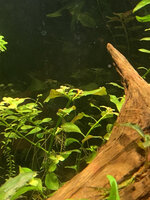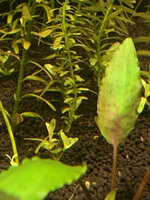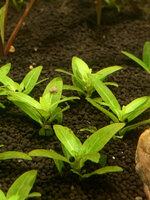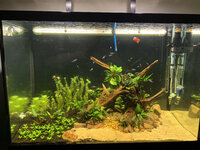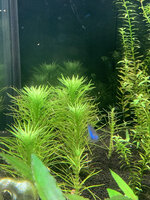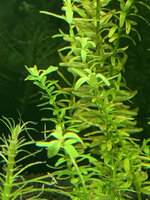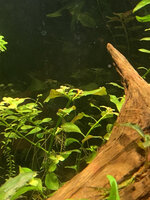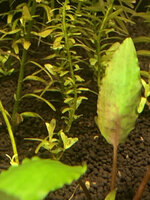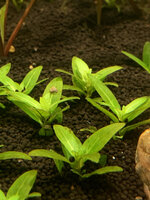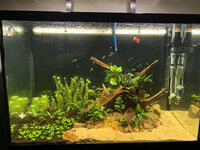I am going to make a few posts to address things 1 at a time:
1) this one for the McCree curve -- really neat findings.
2) Comment on progress on tank
3) Respond to posts
First, I have attempted to cite everything - I didn't go formal (APA,IEEE, etc) but I do want to give credit where credit is due, so if you see any error with my citing, let me know.
It starts here:
Well, after some coffee.
Quoted here: http://econoluxindustries.com/McCree-curve.html
Paper: [1] "The action spectrum, absorptance and quantum yield of photosynthesis in crop plants" - McCree, Keith J. Agricultural and Forest Meteorology 9: 191-216. doi:10.1016/0002-1571(71)90022-7
"The action spectrum, absorptance and spectral quantum yield of CO2 uptake were measured, for leaves of 22 species of crop plant, over the wavelength range 350 to 750 nm. The following factors were varied: species, variety, age of leaf, growth conditions (field or growth chamber), test conditions such as temperature, CO2 concentration, flux of monochromatic radiation, flux of supplementary white radiation, orientation of leaf (adaxial or abaxial surface exposed). For all species and conditions the quantum yield curve had 2 broad maxima, centered at 620 and 440 nm, with a shoulder at 670 nm. The average height of the blue peak was 70% of that of the red peak." [1]

"The Quantum yield Φ of a
radiation-induced process is the number of times a specific event occurs per
photon absorbed by the system." (
https://en.wikipedia.org/wiki/Quantum_yield)
I.e. McCree found that given 1 photo of light with a specific nanometer, the number of times that the event of uptaking CO2 happened a specific percent of time --- in other words, given 1 photon of 600nm red light, the event of CO2 assimilation occurred 100% of the time.
But the event still occurs for every wavelength of light - hence the often quoted, “any light will grow plants”. Some people don’t care about spectrum - But the plants respond BEST to red … what happens to the rest - it tans my skin - OR perhaps algae will utilize other colors better? Maybe not - it is a plant after all. I am not sure.
This is was cool, but it left me with the question -- well how MUCH CO2 is that actually?
To answer this question, we need to know how many photons of light are passing through our system and how much each photon actually uses.
From here: https://www.ncbi.nlm.nih.gov/pmc/articles/PMC3442562/
Hogewoning S.W., Wientjes E., Douwstra P., Trouwborst G., van Ieperen W., Croce R., Harbinson J. (2012). … did some research:
Underlying causes of the wavelength dependence of quantum yield. Quantum yield for CO2 fixation for 18 different wavelengths calculated from gas-exchange measurements (black solid lines) and from the in vivo efficiency balance between the two photosystems (red dotted lines). The difference between the values obtained by the two different methods at wavelengths <580 nm represents quantum yield losses attributable to light absorption by photosynthetic carotenoids and nonphotosynthetic pigments. (A), (B), and (C) correspond to leaves grown under the sunlight spectrum, the shade light spectrum, and blue irradiance, respectively. (Reprinted from Hogewoning et al. [2012], Figure 8.)

What this means is that at each of these specific wavelengths (just as McCree did), a certain amount of MOLS of CO2 is absorbed under these circumstances.
“In contrast with previous studies, the authors assessed the wavelength dependence of quantum yield on an absorbed light basis (termed α)”
Now, “They show in particular that photosystem efficiency balance, reflecting the ratio of photosystem I😛hotosystem II reaction centers, has a strong impact on α (see figure above).”
So this means that the balance of our light output matters -- we can’t just willy nilly assign %’s to spectrum and think we have efficiency -- but clearly the lines look similar … plants will grow with the light.
In: https://books.google.ca/books?id=cnXBnaEFhPwC&pg=PA11&lpg=PA11&dq=0.093+CO2+fixed+per+absorbed+photon&source=bl&ots=M7OwDsjwJn&sig=ACfU3U2fjbhCjlaDTQm9OxrpxdwUQh0KEA&hl=en&sa=X&ved=2ahUKEwjM55nc_-LoAhXETd8KHcM-AoYQ6AEwAnoECAwQJw#v=onepage&q=0.093 CO2 fixed per absorbed photon&f=false
We have,

I think what is more interesting, rather than trying to dig for all of these papers and confirm everything, is that this number of .093 mol per mol absorbed photons is similar to the above paper.
Let’s go with it.
A key is ABSORBED photons -- this is where all of the calculations below will become skewed -- the photon needs to hit the plant -- hence why plant density is actually important
(we increase the probability that a plant will be hit by a photon of light and increase the probability that there is CO2 by that plant with good distributed flow and high concentrations of CO2 and increase the number of photons by HIGH PAR).
So, let me assume that my PAR is

(you need light to get there) at a 2D cross-section of my aquarium. This means, that in a 2D slice 1m x 1m, I have

of photons of light passing by per second. In other words, I have

of photons of light passing by per second. But recall, that each of these photons from our lights could be a different wavelength and has a different relative quantum yield …. So let’s just say that:
For each mol of photons, we absorb .093 mol of CO2. -- we can go ahead and look at percent distributions based on settings etc -- but if just assume everything absorbs like red, then we overestimate the amount of CO2 ... and that uses ideologies of EI ... so......
The natural question is how much CO2 is in my 2D 1M slice … but my tests (pH probe, drop checker) correspond to 3D … so what do we do.
Ideally, if I jam pack that 1M square slice with the appropriate amount of CO2, ferts, and plants to absorb this light and use the nutrients, then I will have great plant growth and release allelochemicals to inhibit algae! Once the plants use it, I just need to make sure I have enough flow so that I replenish them before they are depleted (in the appropriate ratio)? Ensure all is non-limiting.
This is what these beautiful tanks are doing.
Let us assume we have 30ppm CO2 in my 65 gallon tank (I just made it 60 to accomodate for hardscape) (I cannot speak to the distribution in solution here). This means that we have .68 mol/L of CO2 via.

We need mols, so that we can compare it with uptake of photons.
How many photons do we have in at the 2D cross section of my tank each second? My tank actually only constitutes

of the 1M square cross section. So, I have

of photons passing through my tank at every given second.
For each mol of photons THAT HIT A PLANT, we absorb .093 mol of CO2 from the water column.
Sooo… I need .000001225 mol CO2 present everywhere in my tank at every second.

How much do I actually have?
I have no way of knowing what percent of my tank is actually covered in foliage (this would tell me how much of my CO2 in the water column is wasted) -- so let’s say that I have 1% of it that is actually effective. Even if we drop it lower, you will see soon that it doesn't make a huge difference.
This means that of my .68 mol of CO2, I actually have .068 mol of CO2 that my plants can use. At 30 PAR, this will last me 5440 seconds at 30 PAR or 90 minutes (don't forget my PAR also changes as we go deeper sooo.... more variables). That’s why we can turn the CO2 off early -- if we account for loss from everything else that is going
🙂.

Now, my filter is 300GPH, so I am replenishing this (if good flow distribution) at .315 litres/second. So, my CO2 will be depleted faster than I can replenish it - but fast enough. Not everyone advocates for exhorbitant amounts of flow and I think this is why.
We could develop functions to graph the relations between depletion and replenishment but I think that is where the next part comes into play --- and our plants tell us
@Zeus. ... well they tell me LOL.
IMPORTANT
The Quantum Yield refers to the initial rate that the different chlorophyll excitations occur. And as
@dw1305 said, these excitations do even out at a “maximum” -- so there will be an equilibrium somewhere and that is what we are trying to find with a stable pH during the photoperiod -- and as we know it takes time for the plant to reach that equilibria this is why we need a ramp time!
I think I can safely say that in my plants, cellular respiration was occurring at a rate faster than my photosynthetic rate, and I was not reaching the compensation point -- the picture below from
https://www.encyclopedia.com/earth-...lism/environmental-studies/compensation-point demonstrates what I think happened. I had enough CO2 but there were not enough photons to assimilate them.
@alto

--
In my next post I am even more certain about this.
If anyone sees any errors let me know.
With regards,
Josh








